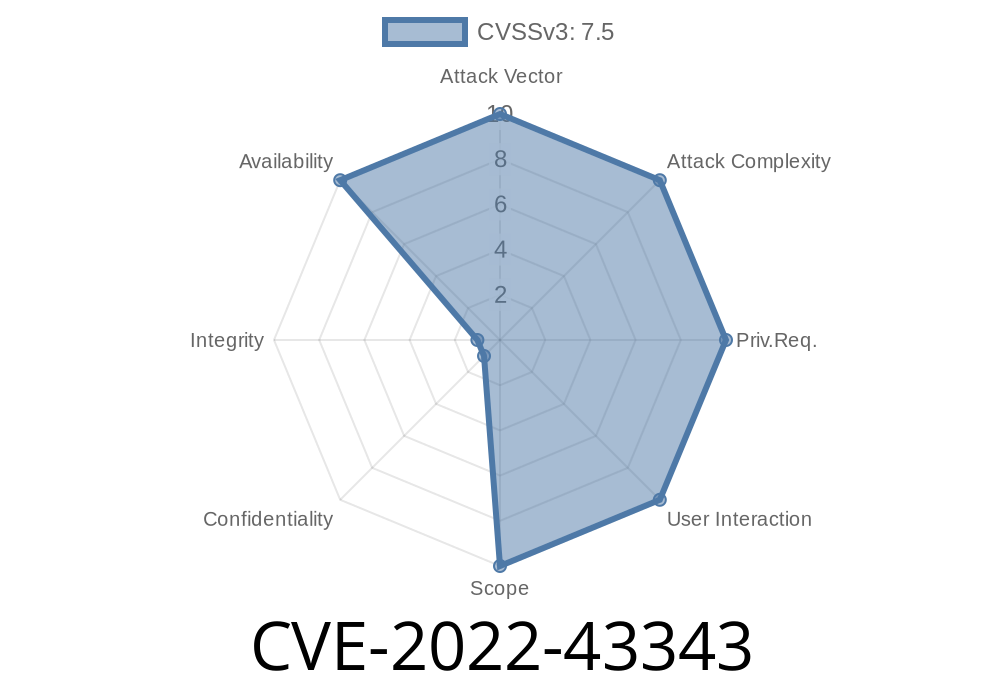A new security vulnerability has been discovered in N-Prolog v1.91, a popular open-source implementation of the Prolog programming language, primarily used for artificial intelligence and symbolic reasoning applications. This post will dive into the details of this vulnerability classified as CVE-2022-43343, including the underlying code snippets, original references, and a thorough explanation of the exploit details.
Highlighted Vulnerability
CVE-2022-43343 is classified as a global buffer overflow vulnerability. It specifically targets the 'gettoken()' function located in 'Main.c' within the N-Prolog v1.91 source code. A successful exploit of this vulnerability could potentially lead to arbitrary code execution on the target system, granting the attacker control over the affected machine.
Code Snippet
To understand the vulnerability, let's first take a look at the code snippet in question, located within the 'gettoken()' function of 'Main.c':
void gettoken()
{
int ret;
char c;
static char buffer[TOKEN_SIZE];
char* bufptr = buffer;
c = getct();
while (c == ' ' || c == '\t' || c=='\n') {
if (c=='\n') line++;
c = getct();
}
ret = isstartpredchar(c);
if (ret) {
do {
*bufptr++ = c;
c = getct();
} while (ispartpredchar(c));
} else {
*bufptr++ = c;
c = getct();
}
*bufptr = '\';
if (bufptr >= buffer + TOKEN_SIZE) {
fprintf(stderr, "Fatal Error: token is too long in line %d!\n", line);
exit(1);
}
}
Here, the 'gettoken()' function scans the input code to identify individual tokens. It uses a static buffer buffer[TOKEN_SIZE] to store tokens, with a pointer bufptr pointing to the current position in the buffer.
The issue arises because the code fails to perform boundary checks before incrementing bufptr in the loop. As a result, when a token longer than TOKEN_SIZE is encountered, the buffer becomes susceptible to an overflow condition.
Exploit Details
Although the code does contain a length check before writing the null terminator '\', it is possible for an attacker to craft an input with a token length just below TOKEN_SIZE, avoiding the triggering of this error message but still causing a buffer overflow when the null byte is written.
For example
% Exploit payload example (approx TOKEN_SIZE characters)
a(<TOKEN_SIZE characters>)
By providing an input like this, the attacker can first avoid the error conditions while still writing beyond the buffer's allocated space. Consequently, this can lead to memory corruption, potentially allowing the attacker to execute arbitrary code on the target system.
You can find more information about CVE-2022-43343 through the following original sources
1. The official Common Vulnerabilities and Exposures (CVE) entry: https://cve.mitre.org/cgi-bin/cvename.cgi?name=CVE-2022-43343
2. The National Vulnerability Database (NVD) entry: https://nvd.nist.gov/vuln/detail/CVE-2022-43343
Recommendations
To mitigate the impact of this vulnerability in N-Prolog v1.91, users should apply any available security patches or updates provided by the software's maintainers. Additionally, be cautious of sourcing N-Prolog-related code or scripts from untrusted developers.
In Summary
In this post, we covered the details of the recently discovered global buffer overflow vulnerability in N-Prolog v1.91, CVE-2022-43343, including the affected code snippet, original references, and exploit details. It is essential for everyone using or developing N-Prolog-based applications to keep an eye on this issue and take the necessary precautions to protect their systems.
Timeline
Published on: 11/08/2022 15:15:00 UTC
Last modified on: 11/08/2022 19:26:00 UTC
